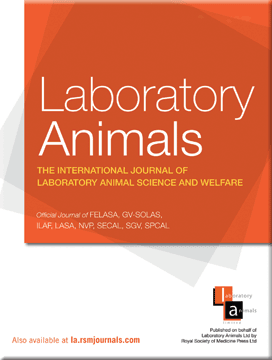
LABORATORY ANIMALS
Scope & Guideline
Fostering dialogue for a better future in laboratory animal science.
Introduction
Aims and Scopes
- Ethical considerations in animal research:
The journal emphasizes the importance of ethical practices in laboratory animal research, advocating for the 3Rs principles: Replacement, Reduction, and Refinement. It encourages researchers to consider humane alternatives and improve animal welfare. - Methodological advancements:
A core focus of the journal is to publish studies that contribute to innovative methodologies in laboratory animal science. This includes statistical methods, experimental designs, and techniques aimed at improving the reliability and reproducibility of research outcomes. - Animal welfare and care:
Research on the welfare of laboratory animals is a significant area of interest. The journal publishes articles that assess and propose enhancements to the care, housing, and handling of laboratory animals to ensure their well-being. - Diverse species utilization:
The journal covers a wide range of laboratory animal species, including rodents, fish, and non-human primates, reflecting the diversity of animal models used in research. This includes studies on specific species' biology, health, and welfare. - Interdisciplinary approaches:
The journal promotes interdisciplinary research that integrates various fields such as veterinary science, behavioral science, and biostatistics to enhance laboratory animal research quality and outcomes.
Trending and Emerging
- Statistical power and experimental design:
There is an increasing focus on the importance of statistical power and robust experimental design. Recent papers emphasize the need for proper statistical methodologies to enhance the reliability and validity of research findings. - Non-invasive and refined techniques:
Emerging research trends include non-invasive methods for data collection and refined techniques that minimize animal discomfort. This reflects a growing commitment to animal welfare and ethical research practices. - Interdisciplinary collaborations:
An increase in interdisciplinary research approaches is evident, with studies integrating insights from fields such as biostatistics, veterinary science, and behavioral studies to improve overall research quality. - Technology-enhanced monitoring:
The use of advanced technologies, including automated monitoring systems and imaging techniques, is gaining traction. These innovations aim to enhance animal welfare and provide more accurate data for research. - Focus on mental well-being of animal care staff:
Recent publications reflect a growing awareness of the mental well-being of personnel involved in laboratory animal care. This trend highlights the importance of support systems and workplace culture in promoting ethical practices.
Declining or Waning
- Traditional animal models for specific diseases:
There has been a noticeable decrease in studies focusing on traditional animal models for specific diseases, possibly due to the rise of alternative models and methods that better align with the 3Rs principles. - Basic anatomical studies:
Research centered solely on basic anatomy without a clear application to welfare or experimental outcomes is becoming less common, as the journal shifts towards more applied and translational research. - Generalized welfare assessments:
Previous trends of generalized animal welfare assessments are declining, with a growing focus on more specific, targeted interventions and evaluations that provide actionable insights into animal care. - Over-reliance on historical data:
The use of historical data without rigorous methodological updates or contextual relevance is diminishing, as the journal encourages more contemporary and methodologically sound approaches to research. - Single-species studies:
There is a waning emphasis on studies that focus exclusively on a single species without considering broader implications or comparative insights across species.
Similar Journals

BERLINER UND MUNCHENER TIERARZTLICHE WOCHENSCHRIFT
Essential Reading for Veterinary ProfessionalsBERLINER UND MUNCHENER TIERARZTLICHE WOCHENSCHRIFT is an esteemed journal in the fields of Veterinary Science and Medicine, published by SCHLUETERSCHE VERLAGSGESELLSCHAFT MBH & CO KG. Since its inception in 1946, this journal has served as a vital platform for advancing knowledge and research in veterinary medicine within Germany and beyond. With a current impact factor that places it in the Q4 category in both Medicine and Veterinary, it continues to provide significant insights for professionals, researchers, and students engaged in the veterinary community. Although it is not an Open Access journal, its rich content contributes to the foundational literature of the field, making it an essential reference. Researchers looking to publish their findings or keep informed on the latest advancements in veterinary and medical practices will find this journal an invaluable resource. It is headquartered in Hannover, Germany, and serves as a testament to the ongoing dedication to veterinary research since the mid-20th century.

Comparative Cognition & Behavior Reviews
Illuminating the evolutionary paths of animal intelligence.Comparative Cognition & Behavior Reviews is a leading open-access journal, published by the Comparative Cognition Society, dedicated to advancing the interdisciplinary field of comparative cognition and behavior. Since its inception in 2006, this journal has become a crucial platform for researchers, professionals, and students alike in the fields of animal science, ecology, and veterinary studies. With an increasing impact on understanding cognitive processes across species, it features diverse articles that explore the evolutionary, ecological, and psychological dimensions of behavior. The journal is particularly notable for its Q3 ranking in Animal Science and Zoology, and Ecology, Evolution, Behavior and Systematics, as well as a Q2 ranking in Veterinary (miscellaneous). Based in Canada, it aims to disseminate high-quality research while allowing free access to its content, fostering a wider dissemination of knowledge. With its continuous growth and commitment to excellence, Comparative Cognition & Behavior Reviews is poised to play an increasingly vital role in shaping the future discourse on cognition and behavior in the animal kingdom.

Italian Journal of Animal Science
Fostering excellence in animal science scholarship.Italian Journal of Animal Science (ISSN: 1594-4077; E-ISSN: 1828-051X), published by Taylor & Francis Ltd, serves as a pivotal platform for the dissemination of cutting-edge research in the fields of animal science and zoology. Since its transition to Open Access in 2002, it has broadened its reach, allowing researchers from around the globe to share their findings and engage in critical dialogue. With its esteemed Q1 ranking in the 2023 category of Animal Science and Zoology and a notable position in the Scopus rankings—ranked 65 out of 490—this journal is a leader in driving the advancement of knowledge in animal science. The Italian Journal of Animal Science aims to publish original research articles, reviews, and methodological papers that contribute to the understanding of animal biology, welfare, nutrition, and conservation, making it a vital resource for researchers, professionals, and students dedicated to advancing the field. Based in the United Kingdom, and with a commitment to excellence, the journal is poised to continue fostering scholarly communication through 2024 and beyond.

ANTHROZOOS
Examining the Impact of Interactions on Society and NatureANTHROZOOS is a premier peer-reviewed journal published by Routledge Journals, Taylor & Francis Ltd, focusing on the interdisciplinary study of human-animal interactions. With a commitment to advancing research in the fields of Animal Science, Anthropology, Sociology, Education, and Veterinary Sciences, this journal serves as a vital platform for scholars and practitioners alike to explore the implications of these relationships in a variety of contexts. ANTHROZOOS maintains a significant impact factor and ranks in the upper quartiles in 2023, showcasing its influence in social sciences and animal studies. Designed for an audience ranging from researchers to professionals and students, the journal not only disseminates original research and critical reviews but also provides insights that can help foster a deeper understanding of how human and animal lives intersect. The journal is hosted in the United Kingdom and does not offer Open Access options, making it a valuable resource within academic institutions. By bridging gaps between disciplines, ANTHROZOOS enhances scholarly dialogue and contributes to the growing discourse in human-animal studies.
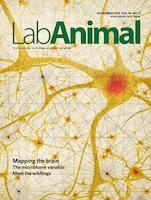
LAB ANIMAL
Exploring innovative solutions for animal welfare and research.LAB ANIMAL, a journal published by NATURE PORTFOLIO, is a prominent source of knowledge in the fields of animal science and veterinary medicine. With its ISSN 0093-7355 and E-ISSN 1548-4475, it serves as a critical platform for researchers, professionals, and students dedicated to the advancement of laboratory animal science. Despite being categorized in the Q4 quartile for Animal Science and Zoology and Q3 for Veterinary (Miscellaneous) in 2023, its contributions are invaluable, reflecting rigorous research and development essential for improving laboratory animal care and ethical research practices. The journal aims to foster innovation and responsive dialogue in an evolving landscape of animal research, promoting a more humane and scientifically sound approach. Although it currently operates under a subscription-based model, LAB ANIMAL continues to be an essential resource for the academic community, providing insights that are integral to advancing both veterinary and animal sciences. The journal has consistently published research since its inception in 1995, engaging a diverse audience with comprehensive studies and discussions that impact the future of the field.
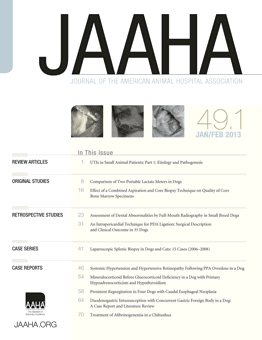
JOURNAL OF THE AMERICAN ANIMAL HOSPITAL ASSOCIATION
Exploring the forefront of small animal health and management.JOURNAL OF THE AMERICAN ANIMAL HOSPITAL ASSOCIATION (ISSN: 0587-2871, E-ISSN: 1547-3317), published by the American Animal Hospital Association, is a premier resource for veterinary professionals, researchers, and students focusing on the field of veterinary medicine. Established in 1973, this esteemed journal serves as a vital platform for disseminating cutting-edge research and clinical insights in the management and care of small animals, boasting a remarkable Q1 ranking in Small Animals and a Q2 ranking in Medicine (miscellaneous), reflecting its high impact in the field. With a Scopus rank of #6 in the veterinary small animals category and a 72nd percentile standing, it offers valuable content covering a diverse range of topics pertinent to animal health and welfare. Although not open access, the journal provides essential resources that contribute significantly to the ongoing professional development of veterinary practitioners and the broader scientific community, thus solidifying its status as a cornerstone of veterinary literature.
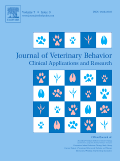
Journal of Veterinary Behavior-Clinical Applications and Research
Bridging the gap between research and clinical application.The Journal of Veterinary Behavior-Clinical Applications and Research, published by Elsevier Science Inc, is a premier outlet for original research and clinical studies in the field of veterinary behavior. With an ISSN of 1558-7878 and an E-ISSN of 1878-7517, this journal serves as an essential resource for veterinarians, animal behaviorists, and researchers dedicated to understanding and improving animal welfare through behavioral science. The journal holds a respectable Q2 ranking in the Veterinary (miscellaneous) category as of 2023, attesting to its significant impact in the field. Although it does not offer open access options, it fosters a community of professionals who are passionate about advancing the application of behavioral research in clinical settings. With coverage extending from 2006 to 2024, the journal aims to disseminate valuable insights that contribute to effective behavior management and intervention strategies, ultimately enhancing the relationship between animals and their caregivers.
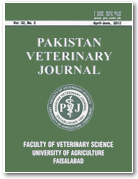
PAKISTAN VETERINARY JOURNAL
Connecting global research to local practices.Pakistan Veterinary Journal (ISSN: 0253-8318, E-ISSN: 2074-7764) is a leading peer-reviewed academic journal published by the University of Agriculture, Faculty of Veterinary Science, situated in Faisalabad, Pakistan. Since its inception, the journal has embraced an Open Access policy, facilitating the dissemination of vital research findings to a global audience and enhancing the visibility of veterinary science. With an impressive Q1 ranking in the veterinary miscellaneous category, the journal ranks #27 out of 194 in the veterinary general field according to Scopus, placing it in the top 14% of the discipline. The scope of the journal encompasses a wide array of topics relevant to veterinary medicine, ensuring that it serves as an essential resource for researchers, professionals, and students alike. By providing a platform for high-quality research from 2009 to 2024, the Pakistan Veterinary Journal continues to play a pivotal role in advancing veterinary science, promoting collaboration among scholars, and addressing contemporary challenges in animal health and welfare.

Abanico Veterinario
Your Gateway to Cutting-Edge Veterinary ScienceAbanico Veterinario is a prominent academic journal dedicated to the field of veterinary science, published by Sergio Martinez Gonzalez. With its ISSN 2007-4204 and E-ISSN 2448-6132, this journal serves as a vital resource for researchers, practitioners, and students interested in the latest advancements and research in veterinary medicine. Although Abanico Veterinario operates on a non-open access model, it provides insightful content that addresses a diverse range of topics such as animal health, veterinary ethics, and innovative practices. The journal aims to promote knowledge sharing and foster collaboration within the veterinary community, ultimately contributing to improved animal care and welfare. With a commitment to excellence and a growing reputation within the field, Abanico Veterinario stands as an essential platform for those seeking to enhance their professional skills and stay abreast of emerging trends in veterinary science.

EXPERIMENTAL ANIMALS
Innovating methodologies for a better understanding of animal models.EXPERIMENTAL ANIMALS is a leading journal that serves the vibrant fields of Animal Science, Veterinary Medicine, and Biochemistry, Genetics, and Molecular Biology, published by the prestigious INT PRESS EDITING CENTRE INC in Japan. Boasting an impressive track record since its inception in 1974, the journal has positioned itself as a crucial platform for researchers aiming to disseminate innovative findings in experimental animal research. With a commendable impact factor and categorized in the Q2 and Q3 quartiles by Scopus in various relevant fields for 2023, EXPERIMENTAL ANIMALS exemplifies excellence in its contributions to science. The journal offers a comprehensive range of articles spanning from animal welfare and experimental methodologies to genetic studies, ensuring a multidisciplinary approach that appeals to a diverse audience of researchers, professionals, and students. Access to its wealth of knowledge fosters significant advancements in research and practice, underlining the journal's commitment to enhancing understanding of animal models in scientific inquiry.